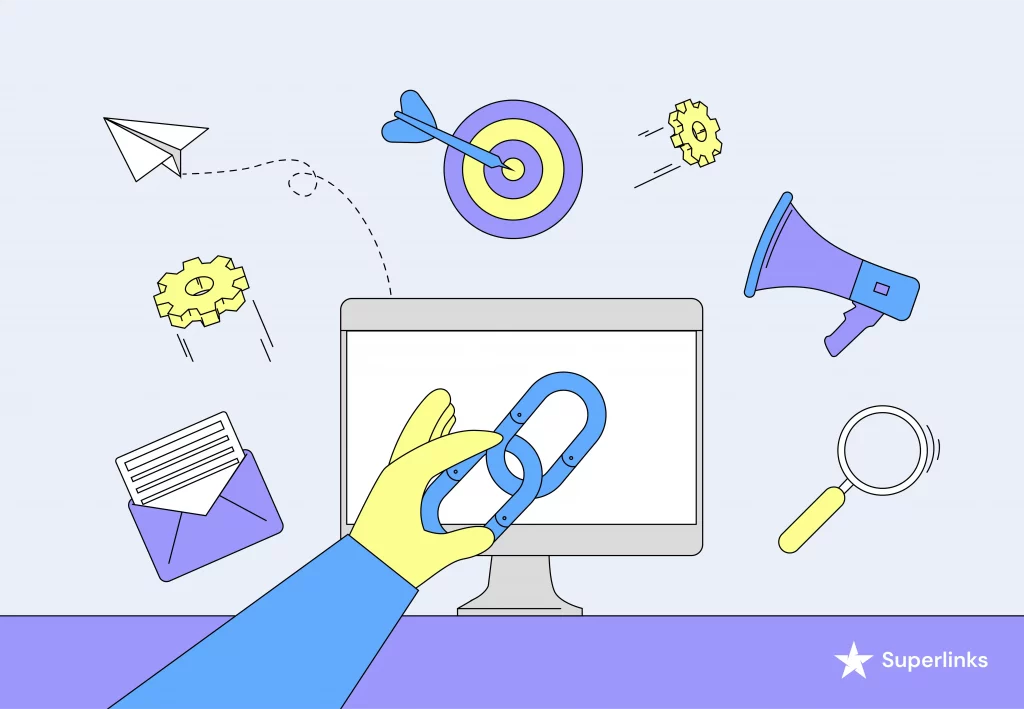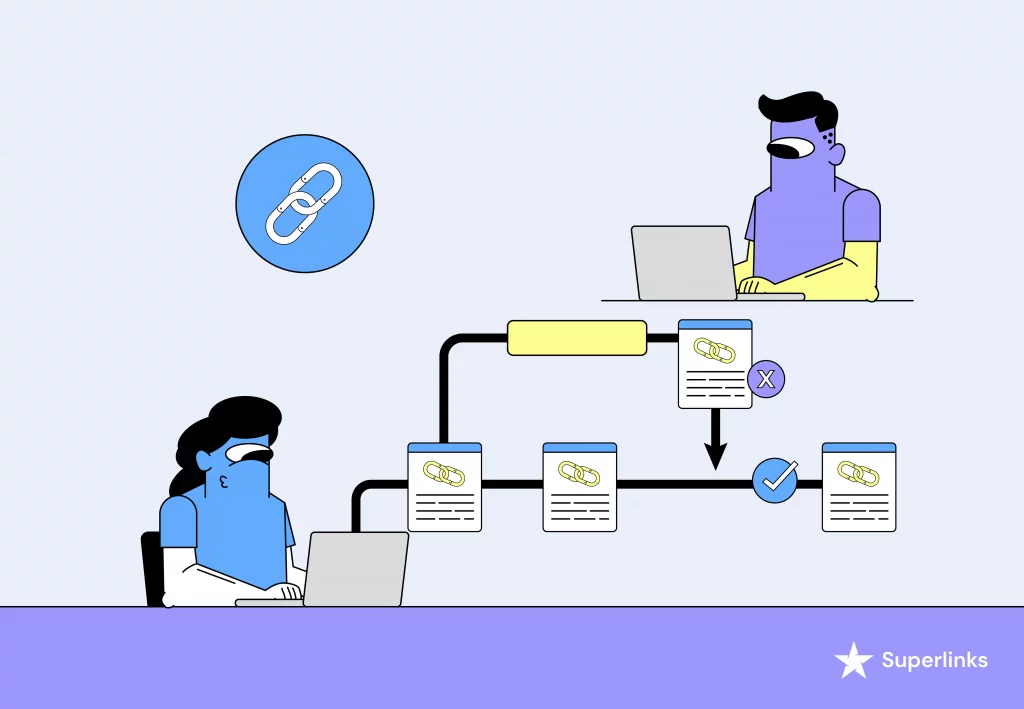Getting more shoppers on your website is a matter of building authority around your brand online. This is where link building comes into play. Simply put, link building is when other sites link your eCommerce website. It is the perfect way to bring new traffic to your website, as it helps with your online reputation by having others refer to it.
Think of it this way: The more high-quality, relevant websites link to content on your website, the more your site will benefit in a few different ways. Below are some of the benefits of link building:
- Links from other websites increase your domain authority
- It will bring you new traffic
- It helps you rank higher in search results
Consequently, this improvement in your SEO translates to more sales.
When it comes to the SEO of an eCommerce website, link building seems to be one of the most challenging aspects of the process—but keep in mind that it is also one of the most rewarding.
The secret to successful link building is developing adequate content strategies and outreach techniques. Doing so will make it possible for you to build links of higher quality more efficiently and increase the visibility of your landing pages and your eCommerce website overall.
Below we have included some of the best and most effective link-building strategies and how to apply them for your eCommerce website to succeed.
Link Building Strategies

When devising a link-building strategy, remember that it won’t be instantaneous. Developing a link-building strategy will take time and effort when done correctly.
Essential to focus on is the quality of your backlinks rather than the quantity. The quality and authority of the pages linking your website are vital in determining how high you’ll rank in search engine results.
There are numerous strategies and practices to build the best links and raise your ranking in the SERPs, and we will go through some of them in this article. Let’s dive in!
Broken link building
One of the best strategies to link building is quite simple. You start from a common problem many websites have, i.e., broken links, and work your way up from there. This is a strategy that nearly everyone can apply as, according to a Semrush study, over 42% of websites have broken links.
The way broken link building works is you find pages on blogs that contain broken links, i.e., links that lead to nowhere, and propose they replace the broken link with a link to your website that provides similar content. This way, you benefit from link building, and the site that links your content eliminates broken links.
Skyscraper technique
This is the technique by Brian Dean of Backlinko.com to grow search traffic by 110% in two weeks. According to him, the Skyscraper technique has three steps:
- Find content worth linking
- Create something better
- Contact the right people
To elaborate: You find content online that has already generated many links, or the “Skyscraper,” and create something better. There are a few ways to do this, like making your content:
- Longer
- Up-to-date
- Better designed
- More thorough, etc.
After creating the content, you reach out to website owners with a site in your niche interested in your topic, as they have already linked to an article on that topic. You do this by email, suggesting they replace the link with one to your website as your content is better for this and that reason.
Resource link building
The next step is using resource links from trusted sites. These resource links will be a guide that you create for your target audience.
When compiling your own, use resource pages from authority sites and blogs like Forbes, Entrepreneur, Huffington Post, Jeff Bullas, Social Media Examiner, and Copyblogger. The goal of using resource articles is to create a more extensive list to generate more backlinks. Below are some examples of what the headlines of your articles could look like:
- X Copywriting Blogs That Will Make You More Money
- X Copywriting Blogs You Didn’t Know Existed, etc.
After you have written the article, reach out via email to the pages you have linked. This could result in them liking your article or even linking your content.
Guest blogging
Guest blogging has been around for some time now, but you won’t reap the benefits of it just by writing any guest blog on just any page. Though it was common practice to get a backlink, it isn’t worth writing a mediocre blog and posting it on a page outside your niche. Instead, you must be more strategic and authentic to benefit from guest blogging. The blogs you write for another site should be unique and relevant to the website, as well as authoritative and attractive for the readers. When done right, guest blogging has several benefits:
- Higher rankings;
- Increased traffic;
- Qualified leads, etc.
Infographic link building
Though many doubt the effectiveness of infographics, studies have shown that they help increase website traffic by up to 12%. Infographics have a few advantages as a link-building strategy. Firstly, they help you generate organic traffic on your website and earn quality links without doing anything or reaching out to others. Secondly, you can use them in practically any article as they are great for visualizing any idea or concept, like data, statistics, research, and findings.
Link Building Best Practices
In addition to the strategies mentioned above, there are also link-building practices that you shouldn’t ignore if you want to succeed. These practices show you what to focus your efforts and time on so that the strategies you implement effectively generate more organic traffic to your eCommerce site. Here are some of the best link-building practices:
Quality over quantity
We are all familiar with the saying “less is more,” and in the case of link building, it’s true if the “less” is of higher quality. While most people make the mistake of trying to gain more backlinks, whether relevant or not, it is better to focus on acquiring quality links, as those will bring more traffic and help you rank higher in search engine results.
Relevance
As we have briefly mentioned above, whatever link-building strategy you implement, be it guest blogging, resource link building, or something else, it is important for the links to be relevant to your niche. One good quality link that is relevant to your website is much more beneficial than a higher number of links with no relevance whatsoever.
Authority
It’s simple: the quality of the backlinks depends on the authority of the website linking your content. So how do you determine the authority of a website? While many might think that the fact a site ranks first in the search results means it’s an authority on the topic, that’s not always the case. However, there are specific ways to determine the authority of a website, like metrics, rankings, content quality, and audience engagement. An easy way to do this is by using tools like the one from Semrush.
Diversity
Using different ways of securing backlinks is crucial to creating a balanced backlink profile that will resist the tweaks and adjustments made by search engines. There are a significant number of link-building tactics you can use to pursue links, all of which fall under one of these three categories:
- Content: e.g., guest blogging, infographic promotion, etc.
- Research: e.g., resource pages and directories, broken link building, unlinked mentions, etc.
- Community: e.g., sponsorships, interviews, partnerships, etc.
Consistency
When implementing link-building strategies, consistency is vital. Gaining quality links and forming relationships with authority pages takes time and effort. Furthermore, consistently posting content is crucial to establishing yourself as an authority, as it will bring you more attention and have Google rank your page higher in the search results.
Link Building Tools

Successful link building is devising strategies to find link opportunities and reach out to convince others to link your content. While link-building can be done without using any tools, you can use some practical tools to make the process easier. Here are some of the best link-building tools:
Ahrefs
Ahrefs is an SEO tool with extensive features to help you optimize your website. In regards to link-building, Ahrefs allows you to:
- monitor your backlink profile,
- discover new link-building opportunities,
- compare your link profile with your competitors, etc.
Semrush
Semrush’s link-building tool helps you with launching and managing outreach campaigns. This tool will also provide a list of link-building opportunities to check out. Lastly, you can use Semrush’s link-building tool to keep track of the success of the strategies you implement.
Majestic
Majestic is another excellent SEO tool that focuses explicitly on backlinks analysis. Below are some of the Majestic features:
- Backlink analysis
- Competitor research
- Backlinks tracking
- Share campaigns
- Site explorer
- Compare sites
- Custom reports
- Metrics history
- Business profile checker
Buzzstream
Buzzstream is a link-building and outreach tool with features like:
- Campaign management
- Email distribution
- Contact management
- Backlink management
- Link analytics
- Ranking monitoring, etc.
Advanced Link Building Strategies

Influencer outreach
Influencer outreach is building relationships through influencers, i.e., people who are active on social media and have a big following. For the influencer outreach strategy to be effective, you need to:
- Find the right influencers for your niche;
- Reach out to them via email for backlinks;
- Follow up after a few days if you don’t get a response from them.
Link roundups
Link roundups are summaries of top links shared weekly or monthly by different websites. Link roundups are a great way to build relationships with other blogs and generate more backlinks. You can use Google or social media (e.g., Twitter) to find link roundups of your favorite niche blogs, create a list, and reach out to them to feature your content in one of their link roundups.
Broken backlink recovery
Broken backlink recovery helps you maintain the SEO value of the links you’ve generated over time. By recovering broken backlinks, you retain link equity or link juice. In addition, reclaiming links decreases the chances of your site visitors landing on a 404 error page, thus ensuring a better user experience.
Unlinked mentions
As this strategy refers to having people discuss your product or website in a positive or neutral tone, only those with a strong brand presence can employ this strategy for link building. There are a few steps to using unlinked mentions as a link-building strategy:
- Find unlinked mentions using tools;
- Check the website’s authority to see if a link from them is worth it;
- Find their contact information;
- Reach out and ask them to link your content.
HARO
“Help a reporter out,” or HARO is another excellent link-building tool. The way HARO works is you answer a reporter’s questions that are relevant to your business or industry. When you respond, you attach the link to your website, so if they use your answer, they also link your site.
Conclusion
Focusing on your website’s link profile is vital for ranking higher in search engine results. A good link-building strategy will include various methods and practices of gaining backlinks like guest blogging, the “Skyscraper” technique, broken link building, infographic link building, link roundups, influencer outreach, etc.
However, when implementing these strategies, it is essential to remember that your site needs high-quality links from authority sites. This is because when it comes to link building, the quality of the links is what matters, not quantity.
By following these link-building strategies and practices, you will gain more traffic for your eCommerce website, guarantee a better user experience for your visitors, and rank higher in search engines.
FAQs
What is link building and how does it work for eCommerce websites?
Link building is an SEO practice that helps you increase your search engine ranking. Search engine algorithms use links to determine the relevance of a page. If a website has a significant number of high-quality links, it means it has valuable content. External and internal linking grant your eCommerce website more visibility and, therefore, more organic traffic.
How do I build backlinks for my eCommerce website?
Building backlinks for eCommerce or product websites is difficult. What works for eCommerce websites is building links to your homepage or content and then using internal links to direct link equity to the pages you want on your website.
What are the best link-building strategies for eCommerce websites?
There are various link-building strategies for eCommerce websites. The best link-building plan will include a mixture of the following:
- Broken link building
- Skyscraper technique
- Resource link building
- Guest blogging
- Infographic link building
Why is link building important for SEO on eCommerce websites?
Developing a good link profile for your eCommerce website is crucial to driving more traffic, establishing yourself as an authority, ranking higher in search engines, and having search engines crawl your website.
What are the best link-building tools for eCommerce websites?
Link building can be done without using any tools, but using them can make the process easier and more efficient. Some of the best link-building tools for eCommerce websites are:
- Ahrefs
- SEMrush
- Majestic
- Buzzstream
How can I determine the authority of a website for link building on my eCommerce website?
There are specific ways to determine the authority of a website, like metrics, rankings, content quality, and audience engagement. An easy way to do this is by using tools like Semrush.
What are some advanced link-building techniques for eCommerce websites?
Some of the advanced link-building techniques for eCommerce websites include:
- Influencer outreach
- Broken backlink recovery
- Unlinked mentions
- Link roundups
- HARO